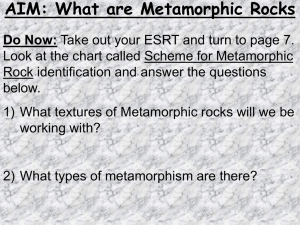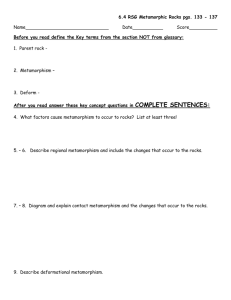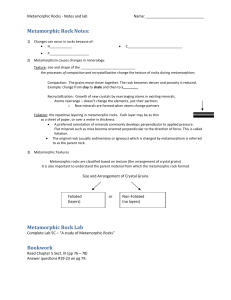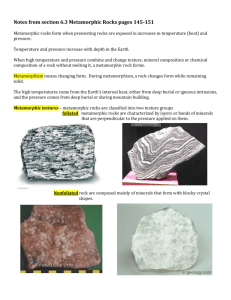Study_Questions_3
advertisement
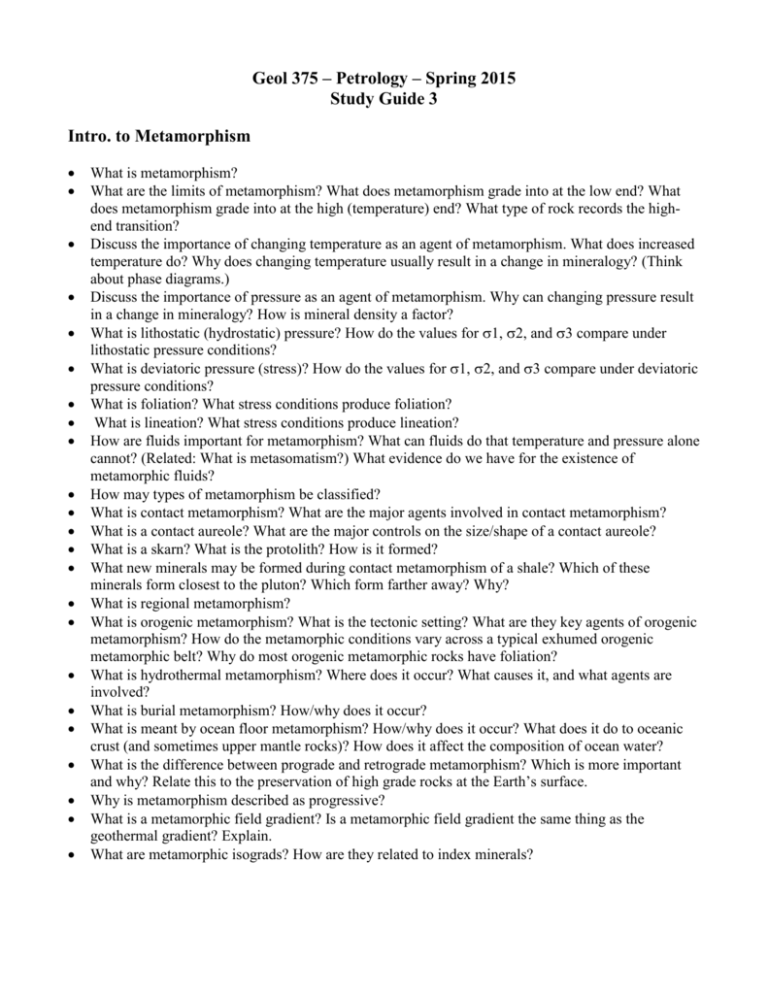
Geol 375 – Petrology – Spring 2015 Study Guide 3 Intro. to Metamorphism What is metamorphism? What are the limits of metamorphism? What does metamorphism grade into at the low end? What does metamorphism grade into at the high (temperature) end? What type of rock records the highend transition? Discuss the importance of changing temperature as an agent of metamorphism. What does increased temperature do? Why does changing temperature usually result in a change in mineralogy? (Think about phase diagrams.) Discuss the importance of pressure as an agent of metamorphism. Why can changing pressure result in a change in mineralogy? How is mineral density a factor? What is lithostatic (hydrostatic) pressure? How do the values for 1, 2, and 3 compare under lithostatic pressure conditions? What is deviatoric pressure (stress)? How do the values for 1, 2, and 3 compare under deviatoric pressure conditions? What is foliation? What stress conditions produce foliation? What is lineation? What stress conditions produce lineation? How are fluids important for metamorphism? What can fluids do that temperature and pressure alone cannot? (Related: What is metasomatism?) What evidence do we have for the existence of metamorphic fluids? How may types of metamorphism be classified? What is contact metamorphism? What are the major agents involved in contact metamorphism? What is a contact aureole? What are the major controls on the size/shape of a contact aureole? What is a skarn? What is the protolith? How is it formed? What new minerals may be formed during contact metamorphism of a shale? Which of these minerals form closest to the pluton? Which form farther away? Why? What is regional metamorphism? What is orogenic metamorphism? What is the tectonic setting? What are they key agents of orogenic metamorphism? How do the metamorphic conditions vary across a typical exhumed orogenic metamorphic belt? Why do most orogenic metamorphic rocks have foliation? What is hydrothermal metamorphism? Where does it occur? What causes it, and what agents are involved? What is burial metamorphism? How/why does it occur? What is meant by ocean floor metamorphism? How/why does it occur? What does it do to oceanic crust (and sometimes upper mantle rocks)? How does it affect the composition of ocean water? What is the difference between prograde and retrograde metamorphism? Which is more important and why? Relate this to the preservation of high grade rocks at the Earth’s surface. Why is metamorphism described as progressive? What is a metamorphic field gradient? Is a metamorphic field gradient the same thing as the geothermal gradient? Explain. What are metamorphic isograds? How are they related to index minerals? What is meant by metamorphic facies? What are the defining minerals for the major metamorphic facies? How might it be better to use metamorphic facies instead of (or in addition to) the simpler concept of metamorphic grade? Compare the P & T conditions of the blueshist, Barrovian, Buchanan/Abukuma, and hornfels series. (How are their metamorphic field gradients different?) Metamorphic Classification and Textures Summarize/describe the range of textures which occur in foliated metamorphic rocks. What textures occur in non-foliated metamorphic rocks? What is a porphyroblast? How do porphyroblasts form? How do spiral porphyroblasts form, and what do they tell us? What is an augen? How do augens form? What are pressure shadows? How do they form? What is crenulation? What is the key criterion for classification of a rock as a marble? as a quartzite? as an amphibolite? What are the key minerals which typify greenshists and greenstones? How do these rocks form? What is a serpentinite? How does it form? From what original kind of rock does it originate? What is a blueshist, and how does it form? What makes blueschists blue? Are they always foliated? What is a mylonite? How/where do mylonites form? What textures can be observed in mylonites? What textural features might indicate a thermal (contact) metamorphic overprint of a orogenic metamorphic rock (e.g. in a phyllite, schist, or gneiss). What are depletion haloes? How/why do they form? What do they tell us? How can shear result in a reduction in crystal size during metamorphism? How can metamorphic rock textures record the direction of shear? How might the textures of a metamorphic rock reveal that more than one phase of deformation/shear had occurred? Plus review Exams 1 and 2 as well as Study Guides 1 and 2. Plus review Phase Diagrams





